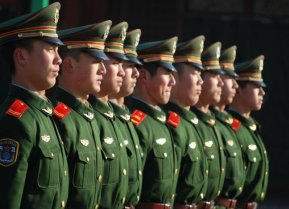China's Military Can't Beat America (Well, for Now)
Beijing might be behind, but it is fast catching up.
Here's What You Need to Know: The U.S. is still favored in any type of major mechanized warfare scenario.
The two-million-strong Chinese Army recently conducted massive attack drills, tested warfare scenarios and practiced combat maneuvers in a large wargame in Northwestern China, raising questions about the extent of the countries’ current preparation for a land war.
The mock-combat operations included day and nighttime “rapid assaults, live-fire strike tests, tactical training and weapons’ tests,” according to a June 9 report in the Chinese People’s Online Daily newspaper.
The exercise included land-attack maneuvers, paratroopers and full-scale war scenarios involving armored vehicles, artillery, mechanized infantry tactics and scout missions.
While the exercises are not likely to be viewed as surprising or unusual for China by Pentagon observers, these kinds of mechanized attack maneuvers, including some of China’s newest modern weapons and armored vehicles, are likely to raise some concerns regarding the land war threat presented by the communist country.
A 2020 assessment from GlobalFirepower estimates that the very large Chinese Army is comprised of as many as 2 million active-duty personnel and 510,000 in reserves, more than two-or-three times larger than the U.S. Army’s standing active force. The assessment also says the Chinese have 33,000 armored vehicles and 3,500 tanks. In addition, China is known to now operate several emerging, high-tech weapons platforms such as its VT5 Type 15 light tank. The VT5, first revealed publicly by China during a military parade last year, has been in development for many years. The roughly 35-ton armored vehicle is, at a cursory glance, comparable in some respects to the U.S. Army’s now-in-development Mobile Protected Firepower (MPF) vehicle.
The Chinese light tank, as described in a detailed assessment in Army Recognition magazine, fires a wide range of ammunition from a 105mm rifle gun with a “thermal sleeve and fume extractor” with a range of 3,000 meters. The rounds, the article explains, include Armor Piercing, High-Explosive Anti-Tank and High Explosive rounds, somewhat analogous to U.S. tanks and Army plans for the MPF. Also, much like the MPF, the vehicle is engineered as a much more mobile, expeditionary, light-weight tank able to traverse rugged terrain. This will allow it to keep up with fast-moving infantry units, and incorporate high-tech reactive and composite armor. Finally, much like the U.S. Army’s Common Remotely Operated Weapons System, which used under-armor targeting and sensor technology to safeguard troops during attack maneuvers, the Chinese VT5 uses a “remotely operated weapon station.”
Alongside the VT5, Beijing’s People’s Liberation Army (PLA) upgraded T99 Main Battle Tank is considered threatening as well, given that the upgraded T99A variant includes a thermal imaging scope, ballistic computer and weather measurement sensors” according to an Army Recognition essay from 2011. Interestingly, its technological maturation may be somewhat analogous to the U.S. Army’s Abrams Tank. The Abrams is, in most respects, an entirely different vehicle than when it first emerged as part of the Big 5 in the 1980s. The T99 first appeared more recently in the late 1990s, however improvements to the 1980s’ era Abrams have completely changed the combat capabilities of the platform; the newest M1A2 v4 variant is engineered with a new generation of long-range, high-fidelity Forward Looking Infrared Sensors, automated gun loader and new multi-purpose rounds for additional attack flexibility, among other things. There have also been major armor improvements and applications over the years, along with more on-board power made possible by an Auxiliary Power Unit. The success of Abrams upgrades, and its combat performance has inspired Army futures to believe that there will likely be a long-term requirement for “heavy armor” such as the Abrams tank. In short, while upgrades to the T99 may be a cause for some concern, there do not seem to be indications that the tank can outmatch the Abrams.
The concept would be to ultimately introduce a new platform, recognizing that legacy platforms can only be upgraded to a certain extent. Therefore, the Army wants to simultaneously engineer an upgraded Abrams to fight alongside a Next-Generation Combat Vehicle. At the same time, weapons developers continue to assess the combat efficacy of next-generation sensors, active protection systems and light-weight armor composites to explore the prospect of a new armored vehicle that is lighter weight, yet more survivable and lethal than an upgraded Abrams. Deliberations, prototyping and technological experimentation are ongoing, but many maintain that some kind of heavy armored vehicle will likely remain, unless there are substantial new technological breakthroughs in the realm of composite armor and other technologies.
While much is likely not known about the particular technical configuration of a Chinese VT5 or upgraded M99A, the Chinese are known to be fast-developing advanced AI computer systems as well as a new generation of both armor and weapons. In short, many observers advise that an actual land war on Chinese soil might not present the best scenario for U.S. forces, given Chinese terrain, advanced weapons and sheer size of their land force. However, Joint U.S attack capabilities include stealth air attack, aircraft carrier power projection, advanced fighters, Naval weapons and a fast-modernizing Army may be quickly changing this equation—favoring the U.S. in any type of major mechanized warfare scenario.
Kris Osborn is the new Defense Editor for the National Interest. Osborn previously served at the Pentagon as a Highly Qualified Expert with the Office of the Assistant Secretary of the Army—Acquisition, Logistics & Technology. Osborn has also worked as an anchor and on-air military specialist at national TV networks. He has appeared as a guest military expert on Fox News, MSNBC, The Military Channel, and The History Channel. He also has a Masters Degree in Comparative Literature from Columbia University.
This article first appeared in 2020.
Image: Reuters


